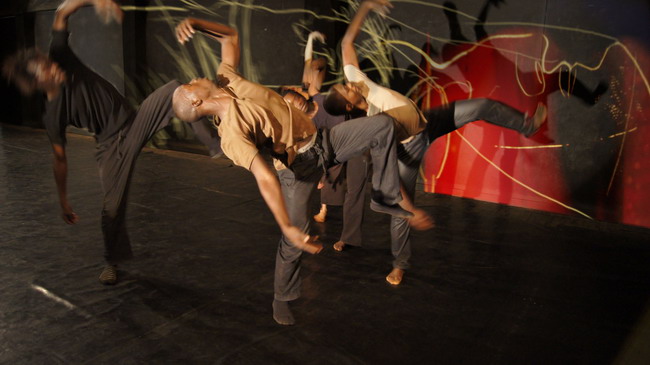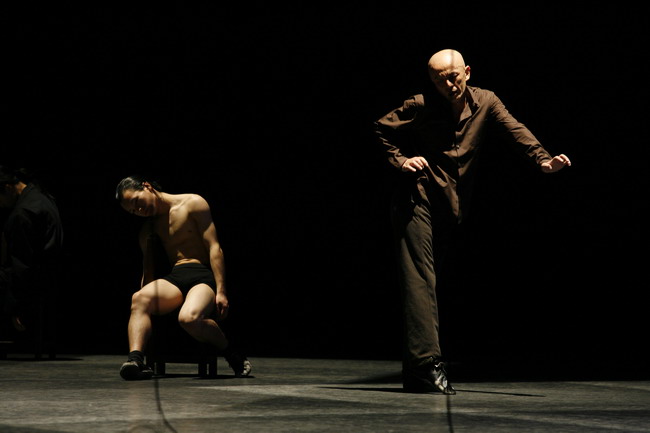Montpellier Danse 2012 - Report
 International dance festival Montpellier Danse was held from 22nd June 2012 to 7th July 2012 this year.
Ideal conditions at Agora de la danse, the venue of the international dance festival Montpellier Danse in the former convent des Ursulines, allow to invite a large number of both foreign and local ensembles every year. They are the pride and prestige of this unique university town located in the Languedoc Roussillon region in the south of France. Festivals undoubtedly make part of the summer atmosphere, and to many they are also a common theme of their holidays.
The influential and politically competent festival director Jean-Paul Montanari is the founder, mainstay and in a sense the patron of a number of festival guests. Of course he has his favourite artists, some of whom can be disputed especially in terms of their artistic qualities, but this is something probably no director of his callibre and influence can be blamed for.
This year's theme was not that original either - "Taste of the Mediterranean Sea". This means that countries concerned were those geographically close to the Mediterranean, but completely different in terms of politics and religion. Of course, this offers a big opportunity to both individuals and small companies to present their work, but in comparison with the high standard of previous years of the festival, guests and unique ideas featured this year somewhat receded from this tradition.
Iranian choreographer Hooman Sharifi presented two different choreographies. If it was not for the exceptionally good band, one would hardly bear to watch the piece Now the field is open at the Opéra Comique till the end. Amateurish, if not dilettante performances of lengthy solo passages by ten very different dancers were really awful. Although Iran has little in common with the Mediterranean, it suited Montanari from the political point of view to include the Iranian artist who lives in Oslo in the festival programme as well.
International dance festival Montpellier Danse was held from 22nd June 2012 to 7th July 2012 this year.
Ideal conditions at Agora de la danse, the venue of the international dance festival Montpellier Danse in the former convent des Ursulines, allow to invite a large number of both foreign and local ensembles every year. They are the pride and prestige of this unique university town located in the Languedoc Roussillon region in the south of France. Festivals undoubtedly make part of the summer atmosphere, and to many they are also a common theme of their holidays.
The influential and politically competent festival director Jean-Paul Montanari is the founder, mainstay and in a sense the patron of a number of festival guests. Of course he has his favourite artists, some of whom can be disputed especially in terms of their artistic qualities, but this is something probably no director of his callibre and influence can be blamed for.
This year's theme was not that original either - "Taste of the Mediterranean Sea". This means that countries concerned were those geographically close to the Mediterranean, but completely different in terms of politics and religion. Of course, this offers a big opportunity to both individuals and small companies to present their work, but in comparison with the high standard of previous years of the festival, guests and unique ideas featured this year somewhat receded from this tradition.
Iranian choreographer Hooman Sharifi presented two different choreographies. If it was not for the exceptionally good band, one would hardly bear to watch the piece Now the field is open at the Opéra Comique till the end. Amateurish, if not dilettante performances of lengthy solo passages by ten very different dancers were really awful. Although Iran has little in common with the Mediterranean, it suited Montanari from the political point of view to include the Iranian artist who lives in Oslo in the festival programme as well.Similarly "ancient" was an expressionistic performance To B. – The Real Tragedy by Spanish dancer Germana Civera. Actor and dancer Radhouane el Meddeb from Tunisia performed an interesting solo depicting the life of Tunisian women - Sous leurs pieds, le paradis. Choreography Ha! by Bouchra Ouizguen is a first-rate piece. The dancer comes from Morocco, where she also danced mainly oriental dances, but she studied in France and collaborated there with renowned choreographers such as Bernardo Montet, Mathilde Monnier and Boris Charmatz. Their influence can be clearly seen in her work.
Merzouki, the audience’s favourite Among the most appreciated pieces featured at the festival were those by Meroud Merzouki, an excellent choreographer and still active hip hop dancer. Premiere performances of two different pieces Yo Gee Ti and Käfig Brasil were followed in the second festival week by author’s earlier work Boxe boxe. A play of joyful and well-combined ideas and situations of high quality movement and hip hop culture was accompanied live by a string quartet /Quatuor Debussy/ that was spontaneously involved in the play itself. The musicians were playing separately, in a ring, standing on their feet or sitting in rollchairs, playing along both solo and ensemble parts of the choreography. In Merzouki’s concept the typically hard and muscular effect the street dance is based on is somewhat reduced in the movement of all dancers, including the hip hop one. The author engages the audiences with the very plasticity and theatricality he has been adding to hip hop in the course of his career and thus cultivating the genre. His productivity, refinement and a rare sense of humour astound the audiences and Merzouki seems to be in a way a kind of modern "Béjart" the spectators have been and, most likely, will be following in the future.
A similar success was the production Mazút by several artists. A performer and dancer Camille Decourtye and Blai Mateu Trias excelled at the Grammont Theatre. A naive story was in this case just a guise for an excellent acrobatic performance. Everyday situations of two partners that took place at home, in the office, on the road naturally intertwined with circus elements, which disrupted them and brought them closer to surrealistic images. The mysterious and subtle Teshigawara
 Compared to those entertaining evening programmes, the piece Skinners – Dedicated to evaporating things by the subtle Saburo Teshigawara made a rather dispassionate impression. Featured for the first time in Europe, the piece is a somewhat long dance suite of both solo and ensemble numbers. Teshigawara’s masterful handling of movement flows, as usual, without touching or any physical contact whatsoever. All performers participate in visualization of various, although more or less repetitive elements, such as air or wind, some kind of refracted time and sped-up jerky, almost short movie loops. However, the most perfect of them all is the brilliant and delicate Rihoku Sato, who also performed at Tanec Praha festival earlier this year.
Compared to those entertaining evening programmes, the piece Skinners – Dedicated to evaporating things by the subtle Saburo Teshigawara made a rather dispassionate impression. Featured for the first time in Europe, the piece is a somewhat long dance suite of both solo and ensemble numbers. Teshigawara’s masterful handling of movement flows, as usual, without touching or any physical contact whatsoever. All performers participate in visualization of various, although more or less repetitive elements, such as air or wind, some kind of refracted time and sped-up jerky, almost short movie loops. However, the most perfect of them all is the brilliant and delicate Rihoku Sato, who also performed at Tanec Praha festival earlier this year.The whole piece is visually harmonized by long white drapes or curtains on both sides, blown by the wind, on the stage naturally courtesy of a stage blower. This creates a unique combination of the subtlety and elusiveness of Teshigawara’s bent gestures on one hand with smooth and slippery movements of transparent white curtains on the other. Maybe it was just the distance between performers and audiences and the sheer spaciousness of Opera Berlioz that somewhat diminished the intimacy and full detail of the Japanese experience and perfectionism.
Black artists excited the audiences with their energy
Salia Sanou engaged the audiences most of all with the energy he, his dancers and musician possessed. They completely captivated the outdoor stage of the Agora theatre with their energy and dynamics and presented what was perhaps the most outstanding performance of this year’s diverse programme. The harmony of theme, choreography, acting and music went hand in hand with the powerful message. Sanou, along with the author of texts, actress Odile Sankara, tried to convey the hardships of crossing borders and embarrassment of those who are checked there, both of which undermines their self-confidence and confidence as such. We felt some sensation of threat and fear also from a potential fall of "funambulus", a tightrope walker, who not only passed a high-taut rope, but his dance steps oscillated somewhere in the air above spectators too. The fragility of his being and his excellent performance brought us to the universal struggle for survival and defense of the identity of each of us.
Unfortunately, this choreographer from Burkina Faso, who has a great reputation in France, does not collaborate with dancer and actor Seydou Boro anymore. The once inseparable duo Salia ni Seydou was in the difficult defence of culture on the African continent legendary. Failed Cherkaoui’s production Something of a disappointment was the performance by Cedar Dance Company from New York. Sixteen outstanding young dancers of the company led by French dancer Benoit Swan Pouffer were somewhat lost in the abundance of movement variations, though these were of the very distinctive dance vocabulary of Sidi Larbi Cherkaoui. It seemed as if Cherkaoui had performed the choreography himself, as if he had been losing confidence in working with the company. Individual performances were great and technically flawless, alas, they were buried and encrypted in a rather cheesy interpretation Orbo nuovo based on literary work My Stroke of Insight by Jill Bolt Taylor. The theme of splitting and unconscious use of the two hemispheres of brain, all this was a basis to a variety of partnering situations, as well as to a characterization of a distracted state of mind. An embarrassingly long and, moreover, unintelligible declamation of a text at the beginning was rather dull and academic. Similarly old-fashioned (though it might have been an intention) were the costumes, looking like the 19th century rural America. The music by Szymon Brzóska, which should have been an integral part of the creative process, was superfluously burdened with almost classically sounding, serious themes in the score played by string instruments. The only dynamic and striking element were decorations depicting the cage, jail, or boards that limited dancers in their motion; we could then watch the performers falling out of them or trying to climb them, break them or overcome them. This Cherkaoui’s production for the New York company definitely does not rank among his masterpieces.
Photo: Festival archive Translation by: Tomáš Valníček


